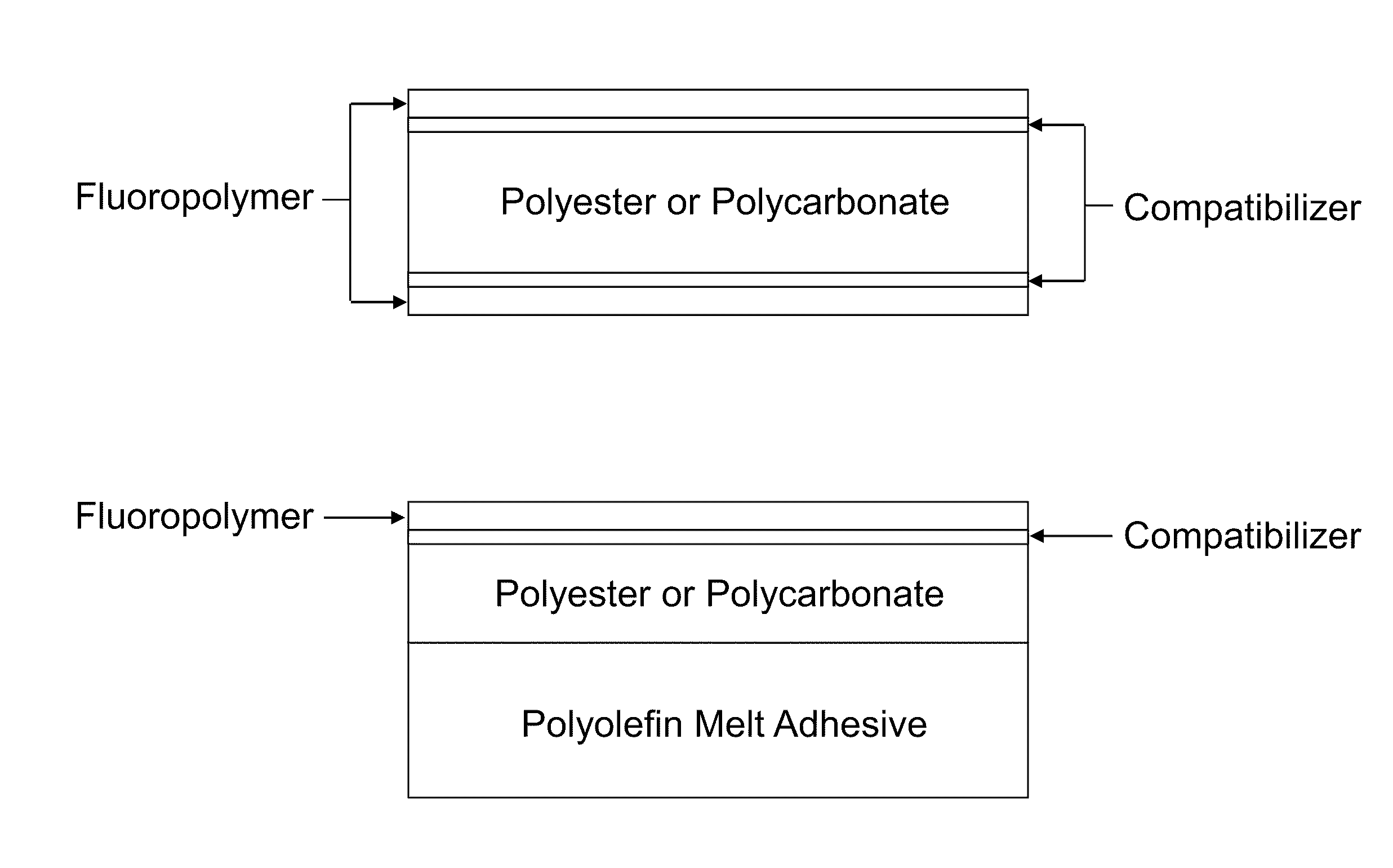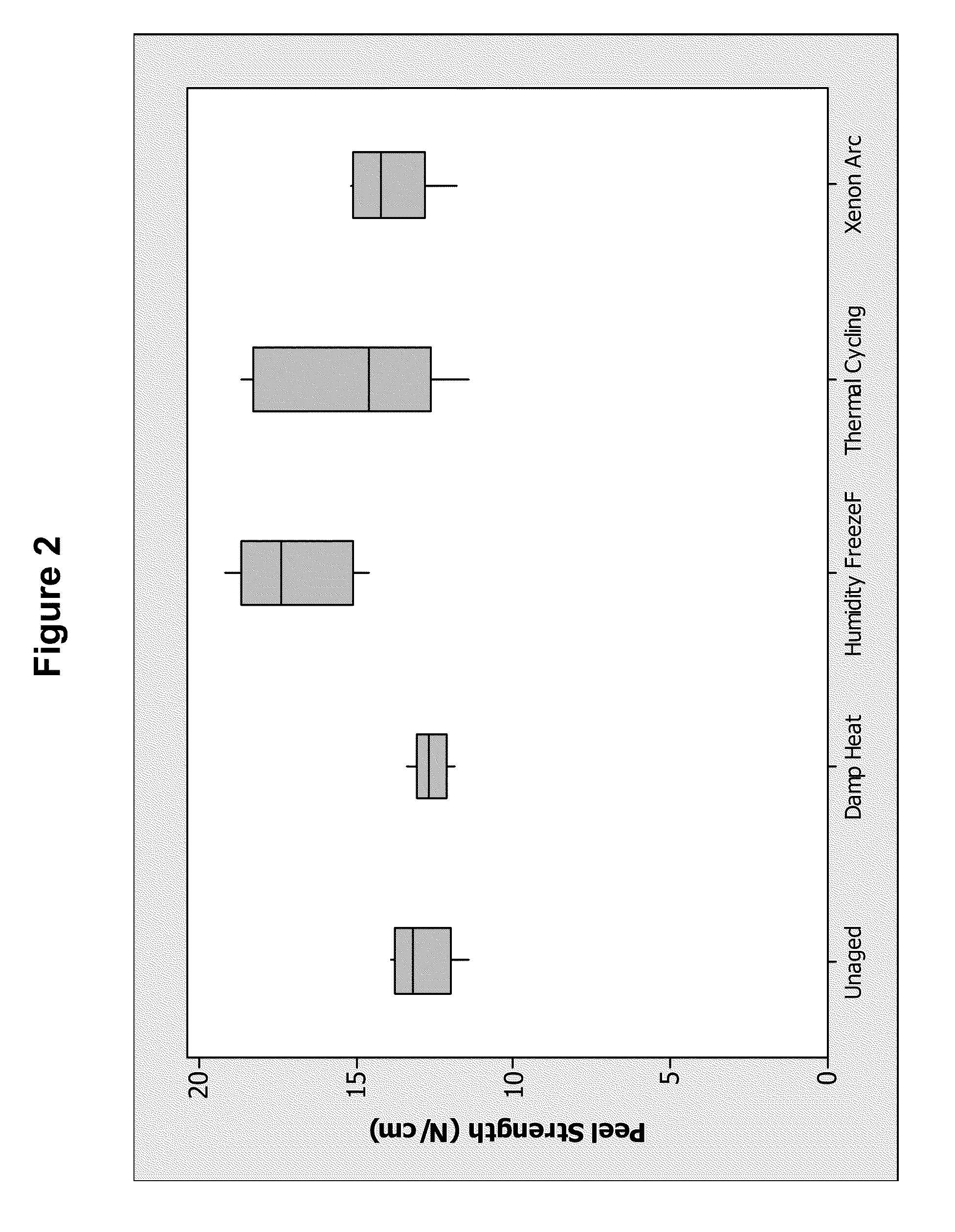Adhesion in ectfe/polyester co-extruded structures using tie layers
a technology of ectfe and polyethylene, applied in the field of multi-layer fluoropolymer films or laminates, can solve the problems of poor adhesion, high cost, difficult handling or processing, etc., and achieve the effect of negatively affecting the function of cells, and reducing the permeability of the inner layer
- Summary
- Abstract
- Description
- Claims
- Application Information
AI Technical Summary
Benefits of technology
Problems solved by technology
Method used
Image
Examples
example 1
[0174](ECTFE+14 wt % TiO2) / EMAC-GMA(ethylene methyl acrylate-glycidyl methacrylate) / PETg (polyethylene terephthalate) 25 / 12 / 125 μm
[0175]Three 1″ extruders with L:D ratios of 24:1, 24:1, 30:1
[0176]Single manifold feedblock and Coathanger Die from EDI Corporation.
[0177]Temperatures
[0178]ECTFE—200, 220, 240, 240, 240° C. (five zones of the extruder).
[0179]EMAC-GMA—150, 180, 210, 210, 210° C. (five zones of extruder)
[0180]PETg—230, 250, 240, 240, 240° C. (five zones of extruder)
[0181]Feedblock and Die—230° C.
[0182]Interlayer Adhesion—8 N / cm Measured by a T-peel test. Te tensile mode was carried out using the universal testing machine from Instron Corp. A strain rate of 50 mm / min was used. Peel strength vs strain was plotted and interlayer adhesion was recorded as the maximum peel strength before breakage or delamination.
example 2
[0183](ECTFE+5 wt % TiO2) / EBAC-GMA (ethylene-butyl acrylate-glycidyl methacrylate) / (PETg+8 wt % TiO2) 50 / 25 / 175 μm
[0184]Three 1″ extruders with L:D ratios of 24:1, 24:1, 30:1
[0185]Single manifold feedblock and Coathanger Die
[0186]Temperatures
[0187]ECTFE—200, 220, 240, 240, 240° C.
[0188]EBAC-GMA—150, 180, 210, 210, 210° C.
[0189]PETg—230, 250, 240, 240, 240° C.
[0190]Feedblock and Die—230° C.
[0191]Interlayer Adhesion—11 N / cm
[0192]The effect of accelerated aging on interlayer adhesion was probed. The aging conditions are described in the following paragraphs and results are presented in FIG. 2.
[0193]Damp Heat—exposure to 85° C., 85% Relative Humidity for 2000 hours, per IEC 61215.
[0194]Humidity Freeze—10 cycles consisting each of 20 hour exposure to 85° C., 85% relative humidity followed by a drop to −40° C., per IEC 61215.
[0195]Thermal Cycling—200 cycles between 85° C. to −40° C. with no humidity control, per IEC 61215.
[0196]Xenon Arc—exposure to Xenon Arc UV aging per ASTM G155.
[0197]...
example 3
[0198](ECTFE+14 wt % TiO2) / EBAC-GMA / LDPE 25 / 12 / 125 μm
[0199]Three 1″ extruders with L:D ratios of 24:1, 24:1, 30:1
[0200]Single manifold feedblock and Coathanger Die
[0201]Temperatures
[0202]ECTFE—200, 220, 240, 240, 240° C.
[0203]EBAC-GMA—150, 180, 210, 210, 210° C.
[0204]LDPE—150, 200, 230, 230, 230° C.
[0205]Feedblock and Die—230° C.
[0206]Interlayer Adhesion—5 N / cm
PUM
| Property | Measurement | Unit |
|---|---|---|
| Adhesion strength | aaaaa | aaaaa |
Abstract
Description
Claims
Application Information
 Login to View More
Login to View More - R&D
- Intellectual Property
- Life Sciences
- Materials
- Tech Scout
- Unparalleled Data Quality
- Higher Quality Content
- 60% Fewer Hallucinations
Browse by: Latest US Patents, China's latest patents, Technical Efficacy Thesaurus, Application Domain, Technology Topic, Popular Technical Reports.
© 2025 PatSnap. All rights reserved.Legal|Privacy policy|Modern Slavery Act Transparency Statement|Sitemap|About US| Contact US: help@patsnap.com



